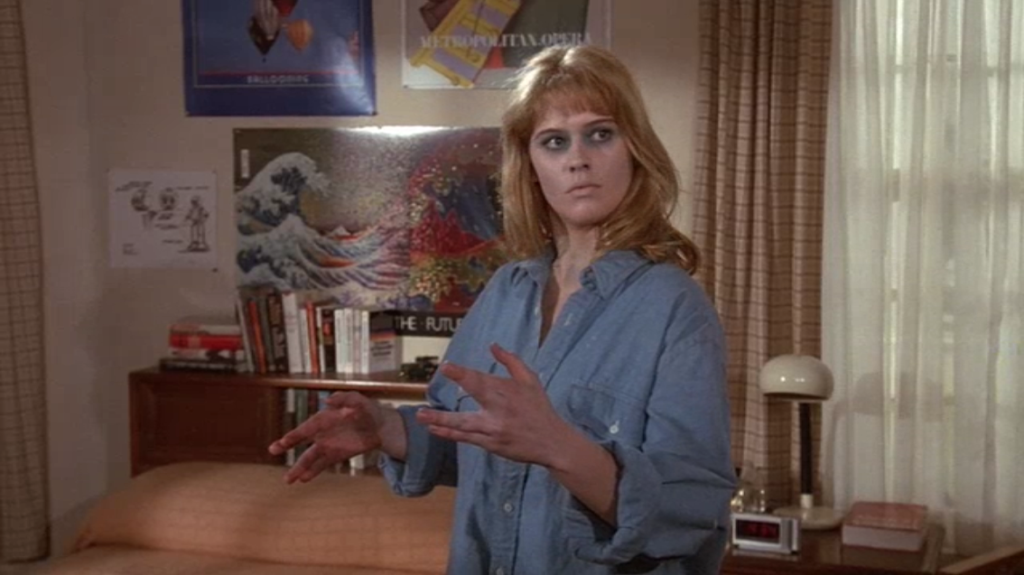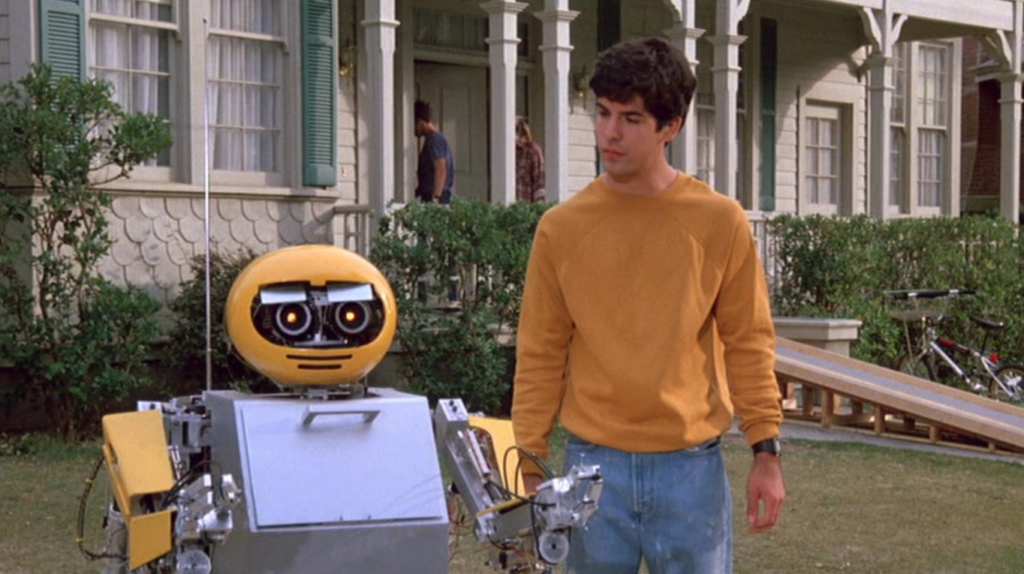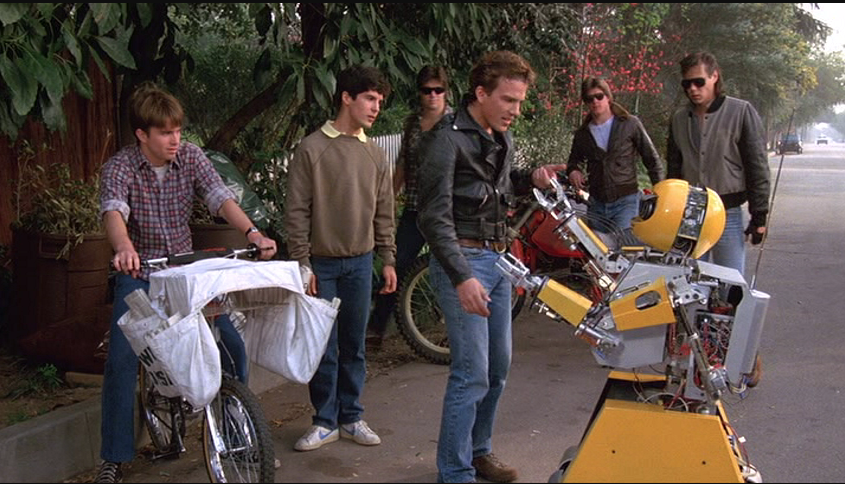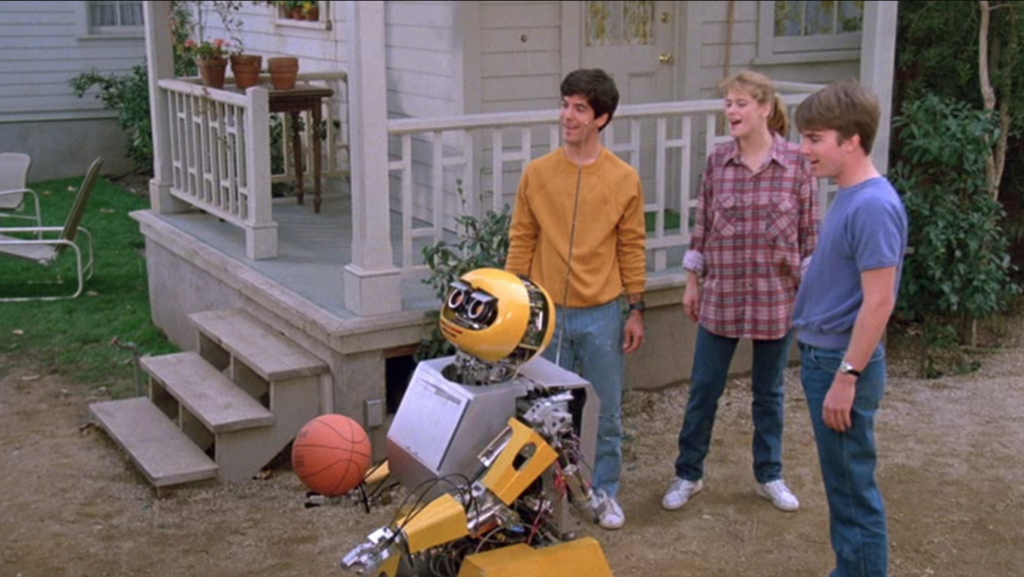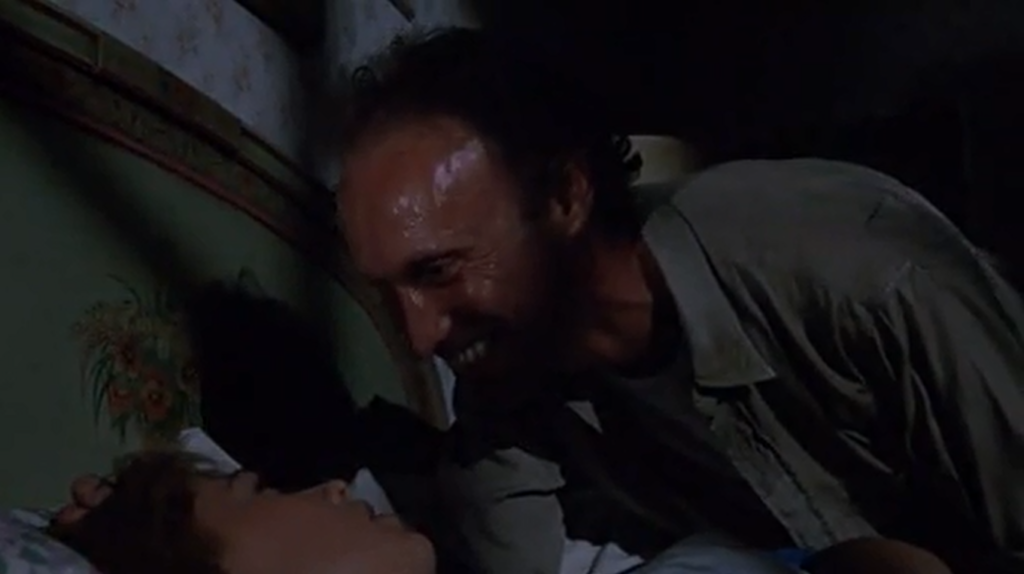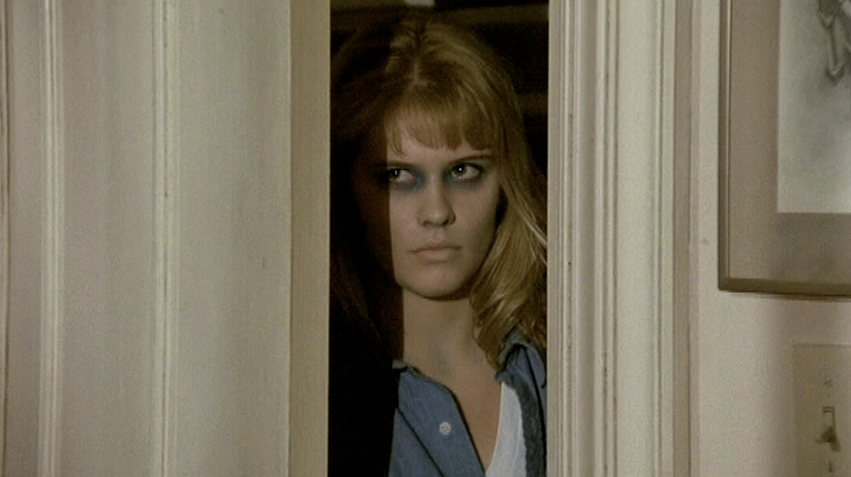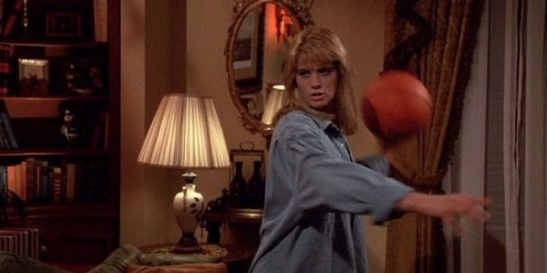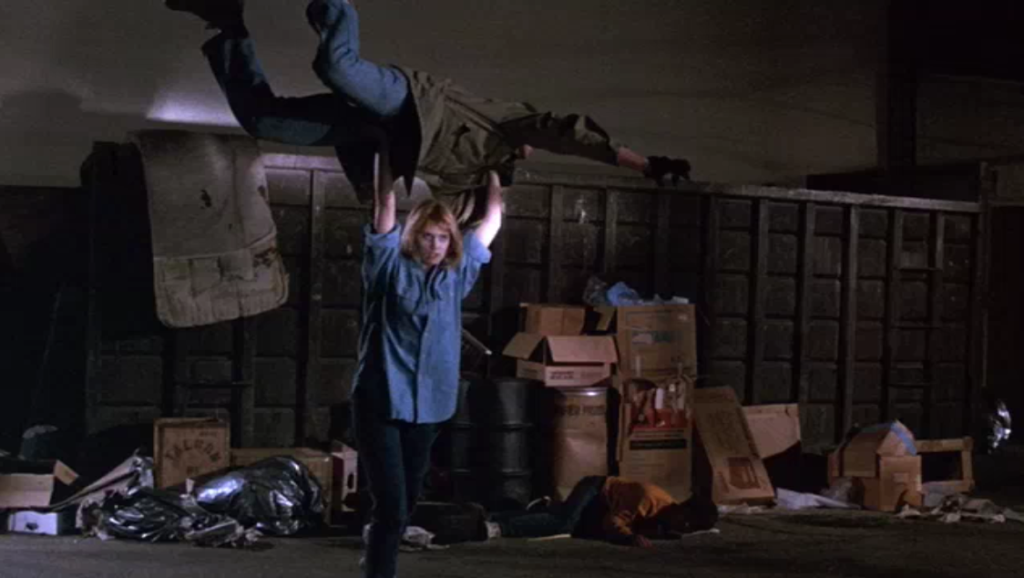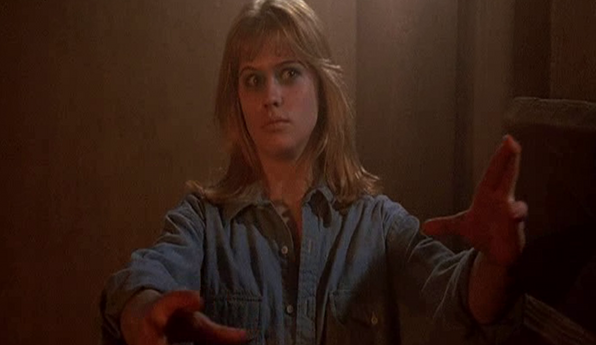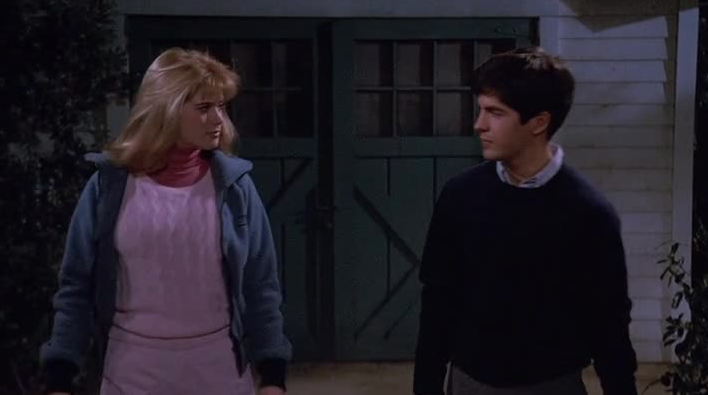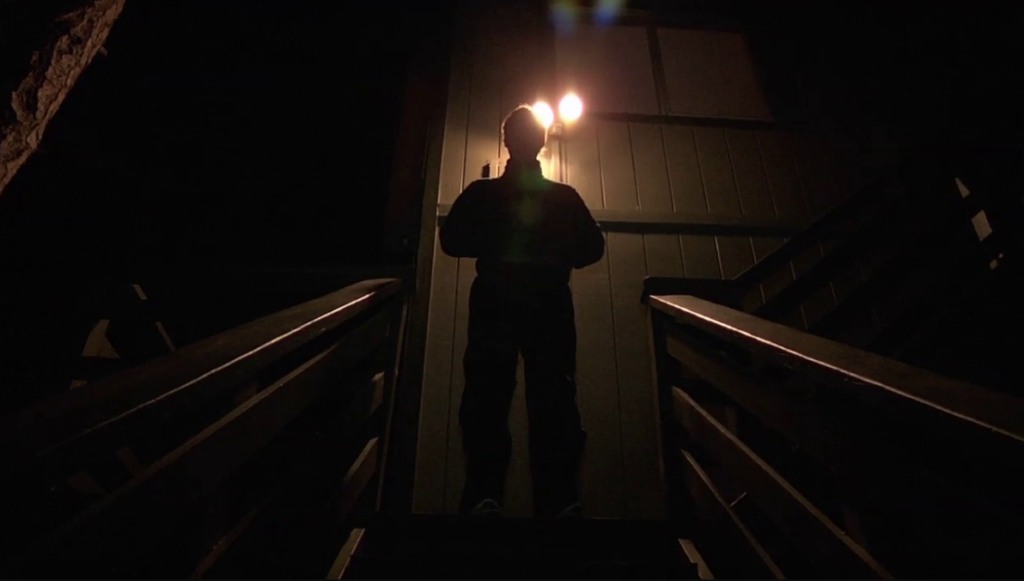
This January, in support of the Toronto Rape Crisis Centre / Multicultural Women Against Rape, friends and family have raised over $1,500 (which, when matched by my employer, totals $3,000). As a result, I now have to watch and write about thirty-one horror movies: one each night. Any donors who contributed over $30 were given the option to choose one of the horror movies I must subject myself to. After each viewing, I will write some things about said movies on this website. Be forewarned that all such write-ups will contain spoilers, and many of them will refer to unpleasant and potentially triggering situations. Today’s film is one considered the first horror film in the relatively new mumblecore genre, Creep, directed by Patrick Brice (The Overnight), and chosen by ECW Press’s Digital Production Manager and Art Director Jessica Albert. You can stream Creep via Netflix (even in Canada!).
What happens:
Trigger warnings: talk of sexual assault, stalking.
Freelance videographer Aaron Franklin (director Patrick Brice) answers a Craiglist ad: $1,000 for a day of filming; discretion is appreciated. He drives to the mountaintop address: a cottage on the cliff side with a yellow door (and old-school doorbell). But no one answers, and the client has no voice mail. The only signs of life are an axe embedded in a tree stump outside. Aaron opts to wait in the car for his video subject to arrive.
The subject, Josef (a magnetic Mark Duplass), scares Aaron by banging on his car door. Dressed in his running gear, he introduces himself to Aaron (who he declares has a kind face), and announces it’s going to be a great day. Josef encircles Aaron in a big hug, then lets him into his family’s old vacation home. Then he explains the job: Josef is a cancer survivor, but a short while ago, he learned he has an inoperable brain tumour. He has two or three months left to live. His wife, Angela, is pregnant with their first child, whom he may never meet. So, just like Michael Keaton in My Life, he wants to make a video diary for his unborn kid. Aaron is to document him over the course of the day as he dispenses advice, goes about his errands, and so on.
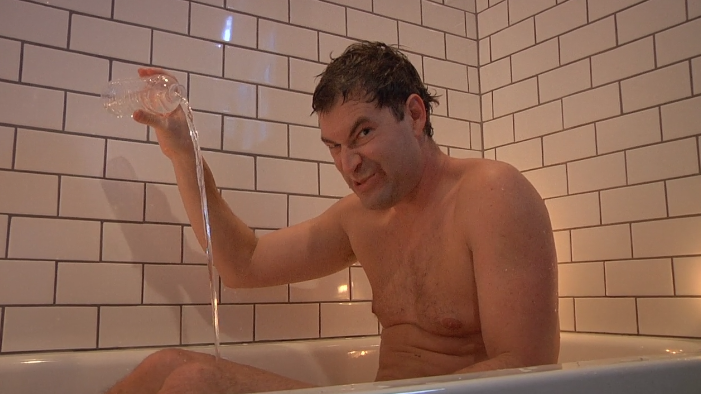
Josef pays Aaron in cash, up front, and after a few high-fives and hugs, he runs up to the washroom for the first scene. Josef immediately begins to strip off his clothes, which sets Aaron at unease. Josef, however, explains: he wants to talk his future child through his first “tubby.” “It’s okay,” Josef assures Aaron. “We’re going to go a lot deeper places than this.” Josef, seated naked in the tub, then mimes playing with a child in the bathtub for an extended period of time. He concludes by confessing to Aaron that he can’t stop thinking about how little time he has left, and wonders if he should just end it now. Josef slides under the water. When Aaron leans over to make sure he’s not drowning himself, Josef leaps out of the water screaming. “Sorry! That was supposed to be a joke,” Josef apologizes, noting he has a strange sense of humour.
The next scene take the duo on a hike up the mountain, but when Aaron goes to borrow a jacket from Josef, he finds an alarming discovery in the cottage closet: a terrifying wolf mask. Josef explains the mask is just “Peach Fuzz,” a character and mask his dad made to entertain the family. He dons the wolf mask and sings a little song about Peach Fuzz to prove his point. With the wolf mask fully explained, they don matching hunter’s caps, and head out to the mountain in search of “The Miracle Waters of the Heart,” a legendary spring on the mountain supposed to possess healing powers. But it only works on the pure of heart.
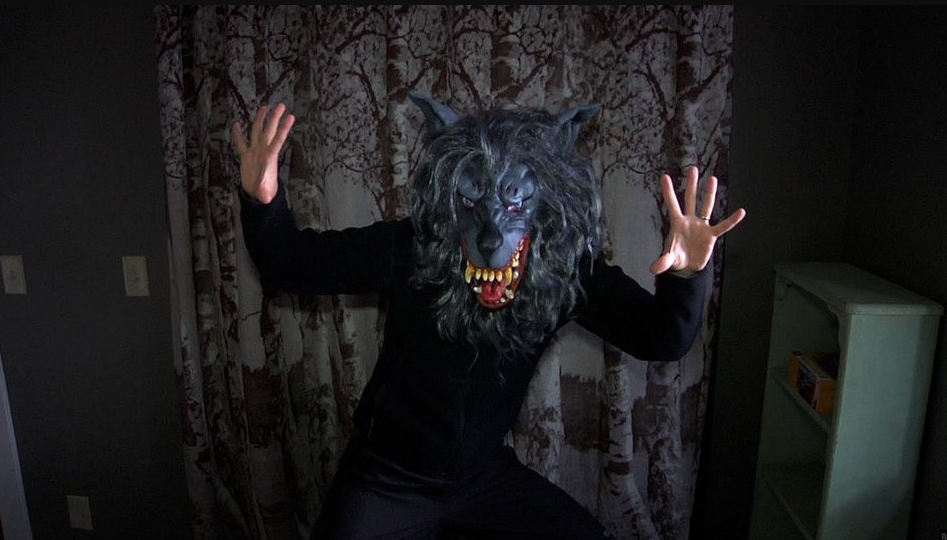
In their journey to this mythical body of water, Josef takes several opportunities to surprise and spook Aaron, saying that the experience of being truly scared is like a near-death experience. “Anybody you need to make peace with,” Josef asks his documentarian, “before you leave this world?” If that question weren’t disconcerting enough, he then asks Aaron if – when he saw the axe outside – he was worried that Josef would kill him. He’s delighted to find the thought crossed Aaron’s mind!
Their search in the woods is looking dire: they find signage for sewer pipelines more readily than natural spring water and Josef confesses to not knowing the way back. But then Josef finds an overlook and what does he find but a waterfall that cascades into a little heart-shaped lagoon! (It’s literally in the perfect shape of a heart.) They both wade in the waters up to their knees and Josef scratches “J + A” into the rock face. After the purifying waters, Josef offers to treat Aaron to a pancake lunch at local diner, Billy Bear’s.
Aaron is further unsettled when Josef seems baffled by the restaurant menu. (Didn’t his family eat here every summer?) But Josef changes the subject and asks Aaron if he’s ever done something he’s felt truly ashamed of. Aaron tells a bizarre story about his childhood history of wetting his pants. Josef uses this as an invitation to talk about his own secret (and far more recent) shame: he photographed Aaron when he first arrived at the house. Josef only pretended to not be home: he was stalking Aaron from the shadows. He says he was nervous about meeting him and apologizes for his deceit. Aaron admits he finds it weird, but he can get past it.
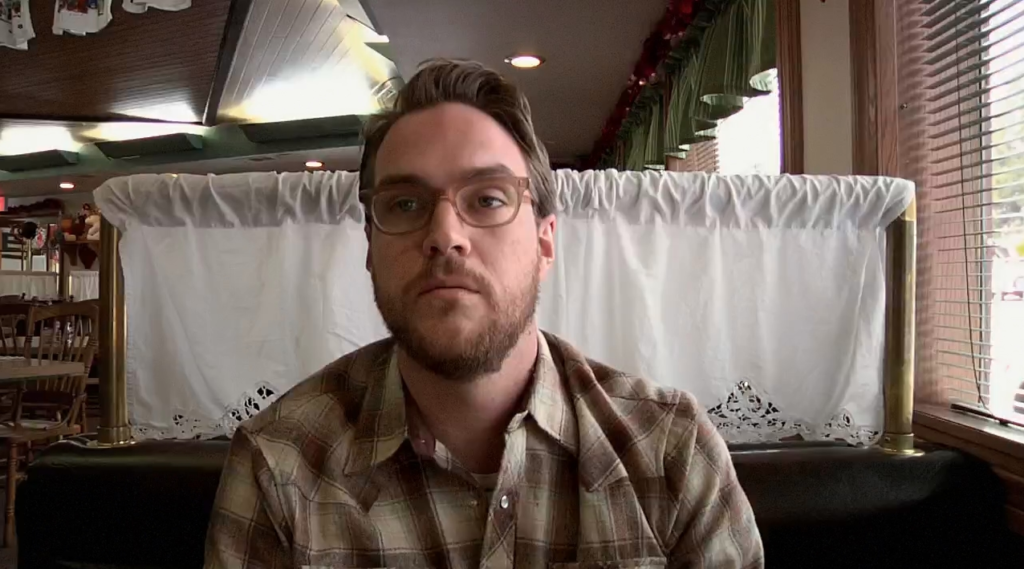
Night descends and Aaron hopes to put the strange day behind him, but Josef wheedles him into staying for one drink. As they re-enter the vacation home, Josef again jumps out to scare Aaron. (It never gets old!) Over their tumblers of whiskey, Josef asks Aaron why he accepted the job. “Money problems?” he wonders. Aaron admits money hasn’t been flowing in, but declines Josef’s offer of financial assistance. Josef says he has an excess of money and is happy to help. (The funniest bit in the film is when Josef tells Aaron he’s hidden a cheque in his boot. When Aaron looks for it, Josef yells “Gotcha!” and says the fact he looked for it means he needs the money.)
Exhausted by Josef’s condescension and weirdness, Aaron starts to leave, but Josef stops him and says he needs to tell him a secret. A secret he doesn’t want on film. He asks Aaron to turn the video camera off, but Aaron leaves the audio recording. Josef then reveals the real story behind the Peach Fuzz mask. Josef did something very bad four years ago. When his internet service was slow, he checked his browser history and found a cache of sites full of animal pornography. Given he wasn’t looking at those sites, it must have been his wife, Andrea. When Josef confronted her about it, she denied it and it drove a wedge between them.
Josef later organized a little vacation for he and his wife – to the family summer home. One night, he went out for a walk and purchased a wolf mask. He broke into his own house wearing the mask, tied his wife to the bed, and proceeded to have “ravenous, animalistic sexual intercourse.” He left and neither of them mentioned the event ever again, and his internet returned to normal service. Aaron cuts off Josef’s concluding statements for the video and begins to rummage around for his car keys. Understandably, he’s in a hurry to get home. Josef is worried he may have freaked out his new friend with the story about essentially raping his own wife. Though Aaron tries to leave, his keys have gone AWOL. Josef talks him into having another drink and just staying the night.
The two men sit down for another drink and Josef feels the whiskey that Aaron poured tastes a little strange. Before long, he’s passed out in front of the fireplace, lazily fondling himself and moaning about “Peach Fuzz.” Aaron riffles through the sleeping Josef’s jacket on the hunt for his keys, but can’t find anything. However, Josef’s mobile phone rings, so Aaron grabs it and runs downstairs so it doesn’t wake Josef. Aaron answers the phone. Andrea is on the other line and recommends that he – whoever he is – leave immediately. We also learn that Andrea is not Josef’s wife, but his sister. Her brother, she cryptically reveals, has problems, and it would be best if he left.
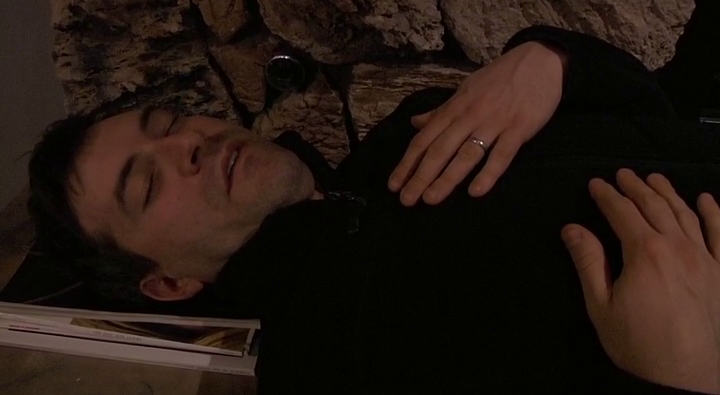
Following the phone conversation, Aaron returns upstairs to find Josef is no longer sleeping in front of the fireplace. Aaron creeps around the house, terrified, and realizes the balcony door is ajar. He ventures outside into the dark, where Josef scares him. “Death. It’s coming,” Josef cries. “Nothing we can do.” He starts to sob uncontrollably and hugs Aaron, who he declares to be such a good friend. Aaron tells Josef that he spoke to Andrea and knows what’s going on, but he’s not angry about the lies. Josef – looking like a trapped animal – panics and rushes downstairs.
Aaron ventures down the steps after his new, unstable friend, and finds Josef with the Peach Fuzz mask on, blocking the front door. “Are you going to let me go?” Aaron asks, but the wolf shakes its head no. Peach Fuzz begins to writhe against the front door, so Aaron makes a break for it, rushing Josef and bowling him over. The video image cuts out.
When the video image returns, we see Josef trudging up a hill, draggind two heavy garbage bags. He drops them at the top of the hill and returns with a shovel and starts to dig. The camera then turns toward Aaron, who explains that – after a scuffle at the door – Josef ran away and Aaron returned home. But a few days later, he received this DVD of Josef shovelling in the mail. Aaron is a little worried that Josef knows his address, but isn’t sure what the video is supposed to mean: is Josef digging a grave? His grave? What’s in the garbage bags?
That night, Aaron makes a late-night video confession: he’s been having disturbing dreams. In them, he’s hot-tubbing with Josef in the heart-shaped natural pool, and they’re both wearing Peach Fuzz masks. The water in the pool gradually turns to blood. Next, Aaron receives a large box with no return address. He opens the box on camera (as one does) and discovers a butcher knife and another DVD inside. He puts the DVD on immediately.
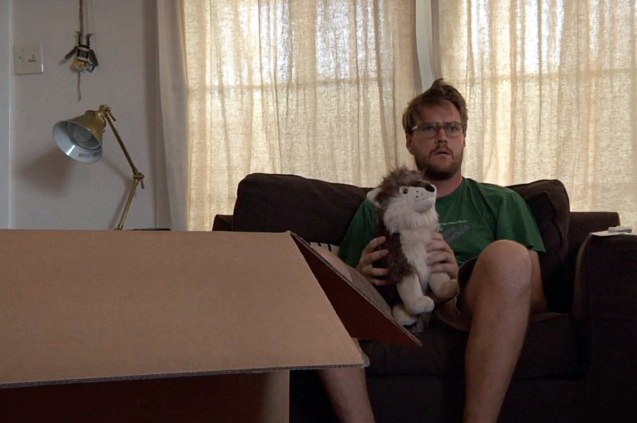
The DVD is another message from Josef, who apologizes for his last video. He also realizes that Aaron drugged him with Benadryl at the vacation home, but he’s no longer mad about it. He tells Aaron to search the box thoroughly: there’s a third gift inside. Aaron pauses the video and digs into the box further to find a wolf cub stuffed animal. Josef explains: he loves wolves because wolves love deeply. But often, they murder the things they love. (It happens.) Josef encourages Aaron to embrace his inner wolf: he tells him to murder the wolf cub with the knife and find the surprise he’s hidden there. The surprise, of course, is an engraved locket – “J & A Forever” – with their photographs inside.
Aaron does something he should have done days ago: he changes his locks and calls the police. Unfortunately, he doesn’t know Josef’s full name or address, and the police are unable to help him much. (One might point out that Aaron, in theory, has hours of video footage of Josef, which would probably make for good evidence.) Aaron’s nightmares persist. As he recounts another one on camera, he hears a large bang and freaks out. Aaron grabs his knife and turns on all the lights. As he patrols the house, we (viewers) see Josef lurking at the front door, though Aaron doesn’t see him. Aaron heads outside and slowly searches around the building, but only sees that his garbage has been torn apart – by raccoons, he presumes. (That rhymes!)
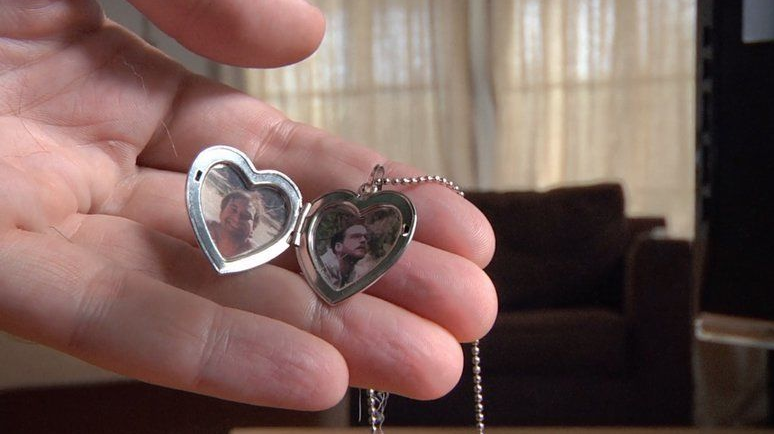
When the camera next starts recording, we seen Aaron sound asleep (so, obviously, he’s not recording this part). Josef leans in and snips a lock of hair from his head. When he awakes, Aaron discovers one more DVD, entitled “My Last Video,” inside his bedroom window. Extremely distressed, he watches the final video. Josef speaks to Aaron from the side of a lake. He went through Aaron’s trash and is disappointed that Aaron discarded the necklace he made for him. He says it sent him into a downward spiral and led him to some inappropriate thoughts. But Josef then had a realization: he and Aaron aren’t friends.
Josef confesses that he’s a liar: he’s pretended his whole life, and it’s driven away friends and family. But he hopes that Aaron’s kindness will allow him to explain in person. He asks Aaron to meet him at Lake Gregory (the spot where he’s filming) at 11 AM the next day. It’s a public spot, wide open, he notes, so there’s no need to fear. Josef says he’s just a lonely, sad person who needs a friend.
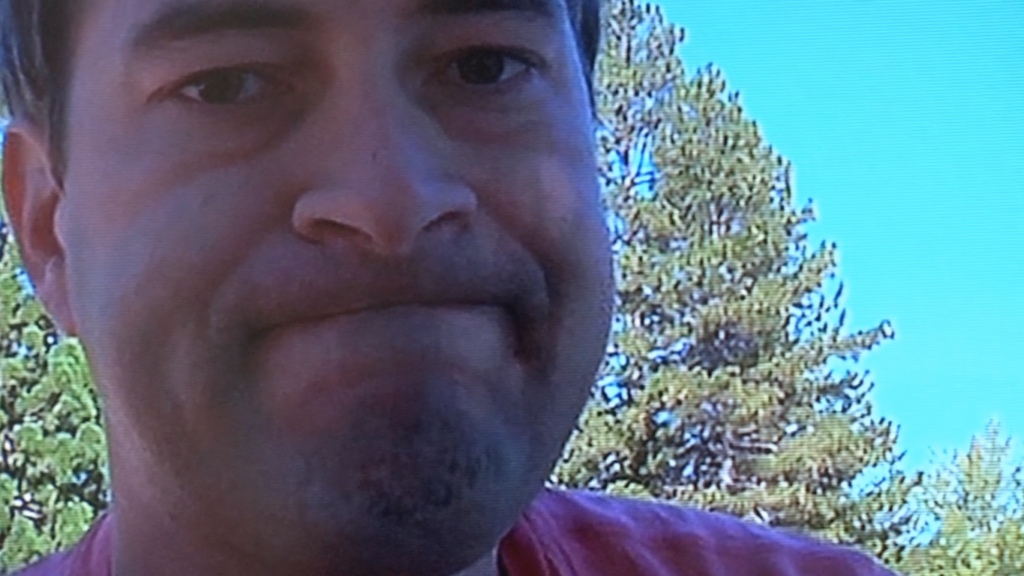
Aaron pauses on the sad face of Josef and can’t help but empathize. The next morning, he drives to the lake, but keeps 911 on speed-dial and keeps the camera rolling. He then leaves the camera on the dashboard of his car and waits on a bench facing the lake. From a distance, we watch in terror as Josef silently creeps up from behind. He then puts on the Peach Fuzz mask, and pulls out an axe from beneath his coat – all unseen by Aaron, watching the lake. Without ceremony, he drops the axe onto Aaron’s head.
The video then cuts to Josef, who comments that watching the scene keeps getting better and better. He can’t imagine why Aaron didn’t just turn around or face away from the lake so he could see Josef coming. But then, he realizes why he didn’t: because Aaron Franklin is the “greatest person who has ever lived.” Josef says, “You always believed I was good,” and that’s why Aaron will always be his favourite murder victim.
Josef (in the past) then leaps in front of the car windshield and screams, scaring himself (while watching the video). The final scene of the film is Josef (now calling himself ‘Bill’) on the phone, explaining a job to a new videographer. As he goes over the details, he places the DVD of Aaron’s death in his closet, alongside dozens of other DVDs and VHS tapes, all marked with a victim’s name.

Takeaway points:
- As the hosts of the popular true crime podcast My Favourite Murder say, “fuck politeness.” Creep is a horror film that demonstrates how easily people die at the hands of murderous sociopaths for wanting to appear nice. Aaron was paid up front in cash; there is no monetary reason for him to stick around, other than Josef has convinced him that he believes Aaron is a kind man, and Aaron wants to maintain that image. This is why he stays for that drink. This is why he never turns him into the police – though he doesn’t have his name or address, he literally has a day of video footage of Josef. But to rat him out to the police shatters that idealized image of a good friend. You will note that this dynamic (trying to maintain niceness) is often a gendered one (though not here in Creep). How many women have had to play nice with predators of various kinds? Either through cultural indoctrination or fear for personal safety. I imagine they, more than anyone, feel the horror embedded in the host’s push to just have “one drink.”
- My wife Meg noted halfway through the film that this is a horror movie as awkward as it is scary. Mumblecore, a genre of which this film is an example, is all about low-budget productions with use of natural and improvised performances. And often, the situations and dialogue turn awkward (as that’s what often happens in real life). Originally this largely improvised film was intended to be a dark comedy, but after showing some scenes to friends, they were convinced to re-write and re-shoot it as horror. Part of the horror of Creep comes from the compellingly awkward figure of Josef. If he were socially adept, rather than so painfully weird and awkward, perhaps Aaron would have known how to react. Would not have felt compelled to react with such performative kindness.
- The real enigma of the film is Andrea. There is an Andrea, though she seems to be Josef’s sister, rather than wife. But how much does she know? She knows Josef is troubled, but does he know he’s killed? And if so, is she not just as monstrous as her brother? Maybe these are questions that Creep 2 – which does exist – answers. (Don’t think I’m not watching that!)
Truly terrifying or truly terrible?: Creep genuinely spooked me. The entire film, you sort of expect what’s coming, but it’s a neat little self-contained creep-out. If it’s any indication, Creep is the only film I’ve had an associated nightmare about immediately afterward. (In my nightmare, the creep was a noted sexual predator in the book world who kept insisting I attend his cousin’s birthday party. But the scenario was otherwise quite similar.)
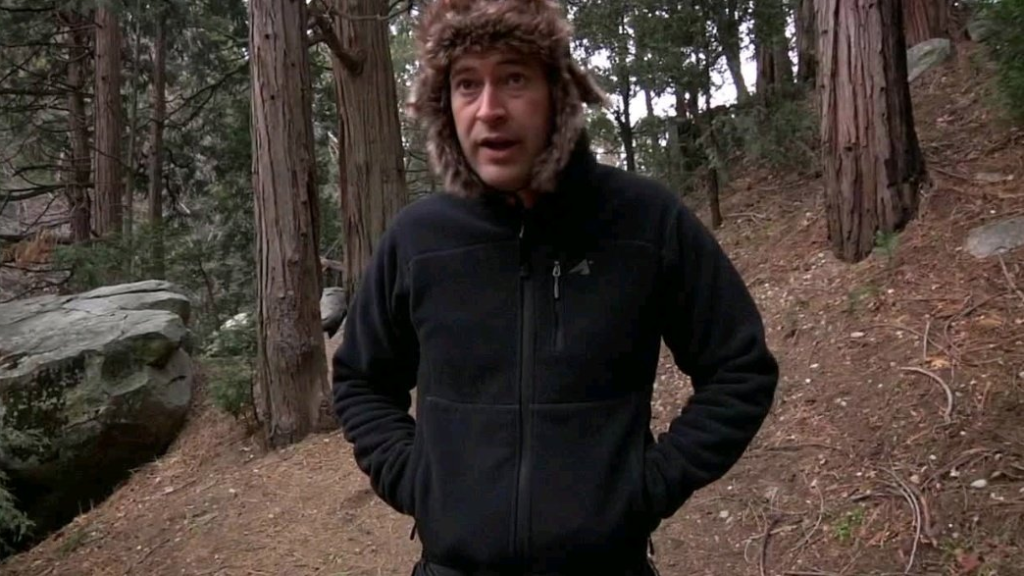
Best outfit: Josef is looking pretty good in those form-fitting track pants and that moisture-wicking top.
Best line: “Tubby time!” – Josef, indicating the point when Aaron really should have left.
Best kill: There’s only one kill, but it’s a great one. It honestly seems like Mark Duplass maybe just killed the director of the film. (I guess that’s the magic of filming at a distance.)
Unexpected cameo: The cast literally consists of two people, but the voice of Angela, Josef’s wife or sister, is Katie Aselton, a regular actor and director of mumblecore films like The Puffy Chair and The Freebie, and Jenny McArthur on television’s The League.
Unexpected lesson learned: I was unaware you can recycle DVDs. Also, never trust a man who readily references the Michael Keaton film, My Life
Most suitable band name derived from the movie: Peach Fuzz, obviously.
Next up: The People Under the Stairs (1991).
